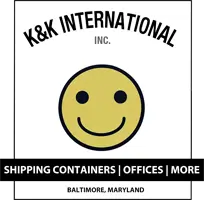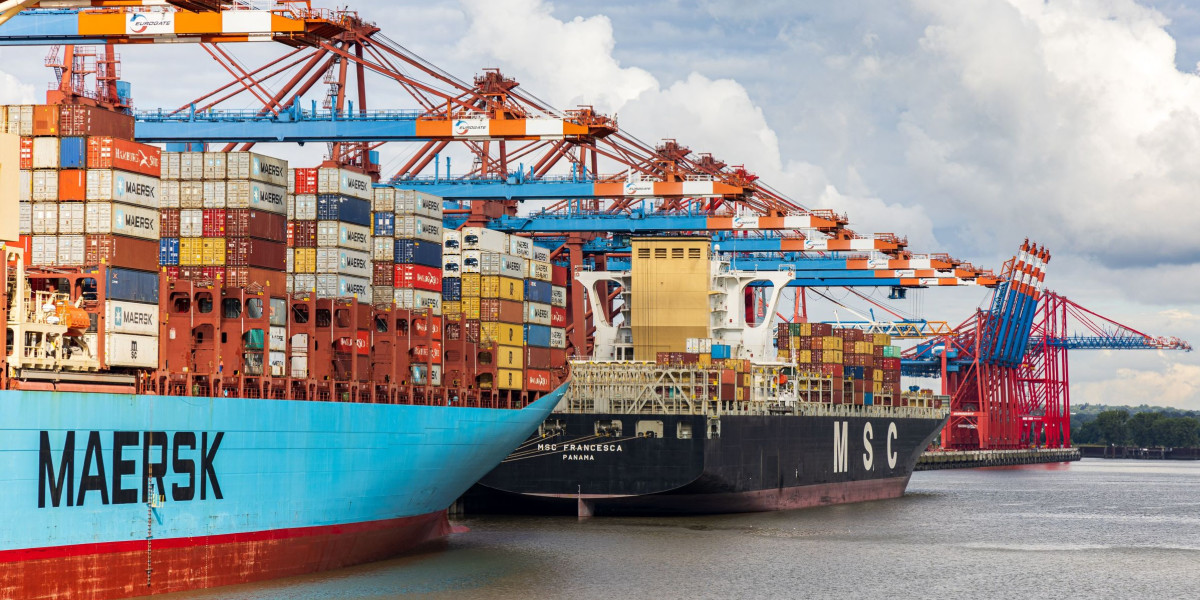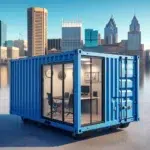Shipping container bars have gained immense popularity in recent years, offering a unique and cost-effective bar experience. The trend of using shipping containers as the foundation for bars has attracted entrepreneurs seeking innovative and customizable spaces.
Interested in starting your own container bar? There’s more than meets the eye. Here’s what you need to know.
Exploring the Trend: Shipping Container Bars
Shipping container bars have emerged as a popular trend in the hospitality industry, providing a fresh and distinctive experience for customers. These bars are created by converting shipping containers into stylish and functional spaces.
The trend of repurposing shipping containers for alternative purposes, such as homes, offices, and retail spaces, has extended to the hospitality sector. Entrepreneurs have recognized the potential of shipping containers as a foundation for creating bars that stand out from traditional establishments.
The popularity of container bars can be attributed to their unique and cost-effective nature. These bars offer a one-of-a-kind experience for customers, with their unconventional design and ambiance.
Additionally, the cost advantages of using shipping containers make them an attractive option for entrepreneurs looking to start a bar business. The ready-made structure of shipping containers reduces the need for extensive construction, leading to lower startup costs compared to traditional bars.
3 Benefits of Using a Shipping Container for a Bar
Using a shipping container as the foundation for a bar brings several benefits. These advantages contribute to the growing popularity of shipping container bars and their appeal to entrepreneurs in the hospitality industry. Let’s explore these benefits in detail.
1. Comfort, Convenience, and Customization
The first benefit of using a shipping container for a bar is the comfort, convenience, and customization it offers. Shipping containers can be modified to include various amenities and features that create a comfortable and welcoming environment for customers.
Plumbing, electricity, insulation, and ventilation systems can be installed to ensure functionality and compliance with health and safety regulations. With proper design and engineering, shipping container bars can provide a comfortable and enjoyable experience for patrons.
The BeerBox in New York City is a shipping container bar that has been converted into a self-contained, fully functional bar. It features a bar counter, seating area, and a tap system for serving craft beers. The interior of the container has been tastefully designed with a modern industrial aesthetic, creating a trendy and inviting atmosphere for customers.
2. Mobility and Thematic Experiences
The second benefit of using shipping containers for bars is their mobility and the ability to offer thematic experiences. Shipping container bars can be designed to be permanent fixtures in a specific location or mobile, allowing bar owners to target new audiences and reach different markets. The mobility of container bars brings flexibility and the potential for increased business opportunities.
Mobile shipping container bars can be transported to various events, festivals, or even different neighborhoods within a city. This mobility allows bar owners to tap into new customer bases and cater to specific themes or events.
You can set up shop at a music festival, offering a unique bar experience to festival-goers. The ability to move your bar to different locations provides a sense of urgency for your customers to visit before you head to the next destination.
The Nomadic Bar in London is a pop-up container bar that has achieved success through its unique design and marketing approach. It’s designed to resemble a vintage train carriage, creating a nostalgic and immersive experience for customers. The bar’s location is carefully selected to target areas with high foot traffic and a vibrant atmosphere. Through social media marketing and collaborations with local influencers, The Nomadic Bar has been able to generate buzz and attract a loyal customer base.
3. More Unique Atmospheres
The third benefit is shipping container bars offer an advantage in creating cool atmospheres that stand out from traditional bars. The unconventional design and layout of these bars contribute to their distinct ambiance, attracting customers looking for a memorable and Instagrammable experience. The novelty of drinking in a repurposed shipping container adds to the appeal and creates a conversation starter for patrons.
The growing number of customization options available for shipping container bars play a significant role in creating unique atmospheres. You can choose different themes, decor styles, and lighting arrangements to set the desired mood.
Whether it’s a cozy speakeasy or a vibrant beach bar, the design possibilities are endless. By carefully curating the aesthetics and ambiance, you can create an atmosphere that resonates with your target audience.
The Treehouse Bar in Cape Town, South Africa, is a shipping container bar that embraces a nature-inspired design. The exterior of the container is covered in lush greenery, creating a unique and visually stunning bar.
Inside, the bar incorporates natural materials, such as reclaimed wood and stone, to further enhance the organic ambiance. This creative design concept sets The Treehouse Bar apart from traditional bars and provides a refreshing and immersive experience for customers.
3 Essentials for Converting a Shipping Container into a Bar
Converting a shipping container into a bar involves several steps and considerations. By following a systematic approach, you can ensure a successful transformation and create a functional and visually appealing space for their customers.
1. Step-by-Step Guide to Conversion
The conversion process begins with careful planning and preparation. It’s vital to determine the size and layout requirements of the bar, considering factors such as the number of customers and staff that the bar will accommodate. Additionally, obtaining the necessary permits and licenses should be a priority to ensure compliance with local regulations.
2. Modifications and Infrastructure
Modifications and infrastructure play a crucial role in the conversion process. Plumbing, electricity, insulation, and ventilation systems must be installed to ensure functionality and compliance with health and safety regulations.
Depending on the location and climate, additional considerations such as heating and cooling systems may also be necessary. Design and engineering are also important aspects to consider. The layout and aesthetics of the bar should be carefully planned to create a welcoming and visually appealing space.
3. Design and Engineering
Design and engineering are two other crucial components of converting a shipping container into a bar. The design should not only be aesthetically pleasing but also functional and efficient. Factors such as the flow of customers, the placement of the bar counter, and the arrangement of seating areas should be carefully considered to create a comfortable and welcoming space.
Engineering considerations include structural integrity, insulation, and ventilation. Since shipping containers were not originally designed to be living or working spaces, modifications are needed to ensure adequate insulation and ventilation. This helps maintain a comfortable temperature inside the bar and ensures the well-being of both customers and staff.
The Box Bar in Miami Beach underwent a thoughtful design and engineering process to create a tropical beach experience. The bar was designed with vibrant colors, palm tree decor, and an outdoor seating area to emulate a beachside oasis. The engineering considerations included insulation and ventilation systems to create a comfortable environment for customers, even during hot summer days.
6 Essential Features and Equipment for a Shipping Container Bar
To create a successful shipping container bar, several features and types of equipment must be incorporated. These elements contribute to the functionality, comfort, and ambiance of the bar, ensuring a positive experience for customers. Let’s explore the five must-have features and equipment for a shipping container bar:
1. Bar Counter and Seating
One of the primary features of any bar is the bar counter. A functional and visually appealing bar counter serves as the focal point of the bar, where customers gather to order their drinks and interact with the staff. The design of the bar counter should be both practical and aesthetically pleasing, allowing for efficient service and creating an inviting atmosphere.
Seating arrangements are also crucial in creating a comfortable and enjoyable experience for customers. The type of seating will depend on the overall design and theme of the bar. Bar stools, comfortable chairs, or even lounge areas can be incorporated to cater to different customer preferences.
2. Refrigeration and Storage
Proper refrigeration and storage options are essential for a shipping container bar. These components ensure the quality and freshness of beverages and ingredients. Refrigeration units should be installed to keep drinks cold and at the appropriate temperature. Additionally, sufficient storage space should be available for storing ingredients, glassware, and other bar supplies.
3. Lighting and Sound Systems
Lighting and sound systems play a crucial role in creating the desired ambiance in your bar. Well-placed lighting can enhance the atmosphere and highlight key areas, such as the bar counter and seating areas.
Dimmable lights can be used to create different moods throughout the day or evening. A quality sound system is also important, providing entertainment and setting the mood with background music or live performances.
4. Utilities and Comfort
Having utilities and ensuring customer comfort are key considerations for a shipping container bar. Amenities such as air conditioning, proper lighting, and refrigerators contribute to the overall comfort of customers. These utilities not only enhance customer experience but also ensure the functionality of the bar operations.
5. Glassware
No bar is functional without sufficient glassware in various kinds. Plan for the fact that you won’t have as much storage or space to clean glassware in a regular bar. Think about smaller glasses that can be stacked and stored even more easily than they would in a conventional bar.
6. Cleaning Supplies
It’s no surprise that bars can get messy quickly, and that’s even truer in small spaces like a container. Stock up on bar cleaning essentials like cotton bar towels, disinfectant, glass detergent, a mop, bucket, broom, gloves, and goggles at the bare minimum.
Make sure to consult your local health codes so you’re compliant before opening. Health regulations are updated often and it’s worth triple checking even if you’re already familiar with them.
The Green Box in Portland, Oregon, is a shipping container bar that incorporates these features and equipment. It has a stylish bar counter with a variety of craft beers on tap, comfortable seating areas, and a well-designed lighting system that creates a cozy atmosphere. The bar also has air conditioning to provide a comfortable environment for customers, even during hot summer days.
3 Cost Considerations for Building a Shipping Container Bar
Building a shipping container bar generally incurs lower startup costs compared to traditional bars. This cost advantage is due to several factors associated with using shipping containers. Let’s dive into three cost considerations for building a shipping container bar.
1. Lower Startup Costs
One of the primary cost advantages of shipping container bars is their lower startup costs compared to traditional bars. The ready-made structure of shipping containers significantly reduces the need for extensive construction.
This leads to cost savings in terms of labor, materials, and time. With less construction required, bar owners can allocate more of their budget towards other aspects such as customization, design, and marketing.
2. Cost Savings in Construction
Shipping container bars offer major cost savings throughout the construction process. The use of shipping containers eliminates the need for traditional building materials such as bricks, concrete, and timber.
Repurposing containers reduces the demand for new materials and minimizes waste, making it an environmentally friendly choice as well. By using existing structures, bar owners can save on material costs and contribute to sustainability efforts.
3. Budgeting Tips
To optimize costs when building a shipping container bar, careful budgeting is essential. Bar owners should conduct thorough research to determine the costs of materials, equipment, and professional services.
It’s advisable to obtain multiple quotes from suppliers and contractors to compare prices and choose the most cost-effective options. Additionally, considering pre-owned shipping containers can result in significant cost savings without compromising quality.
The Container Bar in Austin, Texas, was able to keep costs low by repurposing and retrofitting shipping containers. By leveraging the existing structure of the containers and incorporating salvaged materials, the bar was able to create a unique and budget-friendly space. This approach not only helped to reduce construction costs but also added to the bar’s rustic and eclectic charm.
3 Design Ideas for a Successful Shipping Container Bar
Design plays a vital role in the success of a shipping container bar. Creativity and originality are key factors that attract customers and set a bar apart from its competitors. Let’s explore some creative design ideas that can make your shipping container bar truly unique.
1. Unique Themes and Concepts
One way to create a unique shipping container bar is by exploring different themes and concepts. By choosing a distinct theme or concept, bar owners can create a memorable experience for their customers.
Whether it’s a beach bar, a retro-inspired lounge, or a garden-themed space, the possibilities are endless. Your theme should be carefully considered to align with the target audience and create a cohesive experience.
2. One Example of Success
To draw inspiration, it’s helpful to look at successful shipping container bars that have implemented creative design concepts. The Wahaca Southbank Experiment in London is a prime example. Inspired by Mexican street food markets, the bar offers a vibrant and colorful space that immerses customers in a lively atmosphere.
3. Customization and Branding
Customization plays a crucial role in creating a unique shipping container bar. Bar owners should take advantage of the flexibility that shipping containers offer by customizing the design to reflect their brand identity.
From the exterior aesthetics to the interior decor, every element should align with the overall theme and create a distinct atmosphere. By incorporating branding elements such as unique signage or artwork, bar owners can create a memorable and recognizable brand identity.
2 Environmental Benefits of Shipping Container Bars
Shipping container bars offer environmental benefits through the process of upcycling. By repurposing shipping containers, these bars contribute to reducing the environmental costs associated with traditional construction methods. Let’s explore two environmental advantages of shipping container bars in more detail.
1. Upcycling and Environmental Costs
The use of shipping containers for bars reduces the environmental costs associated with traditional construction. By repurposing existing containers, the demand for new construction materials is minimized, reducing the depletion of natural resources. Additionally, upcycling shipping containers helps to reduce waste and divert materials from landfills, further contributing to sustainability efforts.
2. Durability and Longevity
Shipping containers are built to be sturdy and durable, making them a sustainable choice for bar construction. These containers are designed to withstand harsh conditions during long-distance transportation, ensuring their longevity. The durability of shipping containers minimizes the need for frequent repairs or replacements, reducing the environmental impact associated with constant construction and demolition.
The Green Roof Bar in Montreal, Canada, incorporates sustainable design principles. The bar’s roof is covered in vegetation, providing natural insulation and reducing the heat island effect. This green roof not only contributes to the bar’s energy efficiency but also adds a touch of nature to the urban environment. The use of a shipping container as the foundation for this bar aligns with its commitment to sustainability and environmental stewardship.
Success Factors for Pop-Up Container Bars
Pop-up container bars have gained significant traction in the retail market. Let’s explore the details of success factors for pop-up container bars and how they can thrive in the industry.
The success of pop-up container bars is heavily influenced by the choice of location and effective marketing strategies. Selecting the right location is crucial as it determines the amount of foot traffic and the potential for generating sales. Bar owners should carefully evaluate potential locations and consider factors such as visibility, accessibility, and the target market.
Effective marketing strategies are also key to the success of pop-up container bars. Social media platforms, collaborations with local influencers, and word-of-mouth marketing can help generate buzz and attract customers. Bar owners should focus on creating a strong brand identity and leveraging digital platforms to reach their target audience.
Case Studies of Successful Shipping Container Bars
Case studies of successful shipping container bars can provide inspiration and insights for aspiring bar owners. Let’s explore two examples of shipping container bars that have achieved success through creative design, customer appeal, and community engagement:
- SteelCraft: SteelCraft is a community-driven concept in California that features multiple shipping container eateries. The bar has successfully created a communal dining experience, bringing together various food and drink vendors in a shared space. The innovative approach and community engagement have contributed to its success.
- Mersea: Mersea in San Francisco is known for its exceptional food and vibrant atmosphere. The bar has garnered a reputation for providing a unique and enjoyable dining experience. With its shipping container structure and lively ambiance, Mersea has become a go-to spot for locals and tourists alike.
These successful examples highlight the potential for creativity and customer appeal in shipping container bar design. By combining innovative design concepts, strategic location selection, and a focus on customer experience, shipping container bars can thrive in the competitive hospitality market.
Shipping container bars provide an innovative and cost-effective approach to the hospitality industry. With their comfort, convenience, and customization options, these bars offer exciting and unforgettable experiences for customers.
Ready to start your container bar journey? Request your quote now and we’ll have details over to you within two to three business days. We look forward to working with you!













